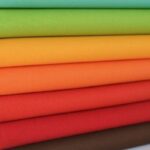An example of one of the most basic textile weaves utilized in the whole of India and is internationally is the plain weave. It is highly valued for its strength and simplicity, thus it finds its application in fashion, home décor, and industrial sectors. This article covers what plain weave is, how it works, its structure, and practical examples while optimizing for SEO phrases like “plain weave fabric,” “plain weave structure,” “plain weave examples.”
What is Plain Weave?

Plain weave is the easiest and most popular stitch utilized in textile production. It requires alternatively interlacing warp and weft yarns, whereby each weft thread goes over one warp thread and under the succeeding one.
This fundamental over-and-under technique produces flat, strong, and tightly woven fabric. Items such as cotton, polyester, silk, and linen are usually used for plain weave.
Plain Weave Structure
The structure of plain weave is highly uniform and balanced, providing durability and firmness. Here’s a basic breakdown of its structure:
| Element | Description |
|---|---|
| Weave Pattern | Over one, under one |
| Warp Yarn | Runs vertically on the loom |
| Weft Yarn | Runs horizontally and interlaces with warp |
| Appearance | Checkerboard-like, tight weave |
| Properties | Durable, wrinkle-resistant, firm surface |
Plain weave fabrics are less likely to snag and are generally inexpensive to produce, making them a go-to option for bulk textile production in India and beyond.
Examples of Plain Weave Fabric
Different types of plain weave fabrics are widely used in India and other parts of the world. A few of them are listed below:
- Cotton Muslin – A type of cotton fabric known for its light weight and breathability. It is often used for nursing infant clothes and summer clothes.
- Chiffon – This type of fabric is largely used for women’s ethnic and Western dresses because of its sheer nature.
- Organza – Used widely in the bridesmaid industry, it is stiff and transparent.
- Taffeta – It has a crisp texture and is ideal for evening gowns and other formal wears.
- Poplin – It has a high durability and is smooth which makes it ideal for shirts and even uniforms.
Advantages of Plain Weave
- Durability – Higher strength because of the strong interlocking pattern.
- Ease of manufacture– A very simple design making it ideal to mass produce.
- Versatility– Plain weave can be done with any yarn type.
- Wrinkle resistance– The fabric keeps its shape well and wrinkles very lightly.
- Low cost– Plain weaves are less expensive to make than intricate weaves.
Applications of Plain Weave in India
The vibrant Indian textile industry employs plain weave fabrics in a sheer number of both contemporary and traditional applications. Some notable uses include:
- Apparel: sarees, kurtis, shirts, and trousers.
- Home Textiles: curtains, bed linens, and cushion covers.
- Industrial Use: filter fabrics, medical gauze, and scrim.
Bindy Enterprises’ market research indicates that India is one the most important plain weave fabric producers in the world, and so, remains a key industrial plain weave manufacturer.
Conclusion
Plain weave is a fundamental method of textile plain weaving anything from cotton to muslin or even industrial fabrics and planar constructions is known for its essences strength and versatility. Working with cotton muslin in traditional garments obporaus knife sutra with synthetic fibers for industrial applications can always rely on plain weave,providing cost-effective solution. Its well-balanced structure and great versatile usages in combined with fashion, home accessories, and technical textiles make this weave widely preferred.
Frequently Asked Questions (FAQs)
1. How does plain weave differ from other weaves?
With its straightforward one-over-one-under structure, plain weave differs from twill and satin weaves which are more intricate and incorporate some form of diagonal and glossy effects.
2. What is the suitability of plain weave for heavy duty use?
Exactly that, its closeness in structure gives strength which makes it useful for industrials and heavy wears such as upholstery, technical curtains and other fabric composites.
3. Can plain weave be applied with synthetic fibers?
Without a doubt. Synthetic materials such as polyester and nylon make plain weave stronger and water resistant, making them excellent candidates.
4. What is the reason for the popularity of plain weave in Indian textiles?
Its well known in Indian industry as its easy to produce, uses many types of yarn and its cost effective.
5. Is fabric made from plain weave breathable?
Carefully fabricated with natural fibers like cotton, plain weave is breathable too.



